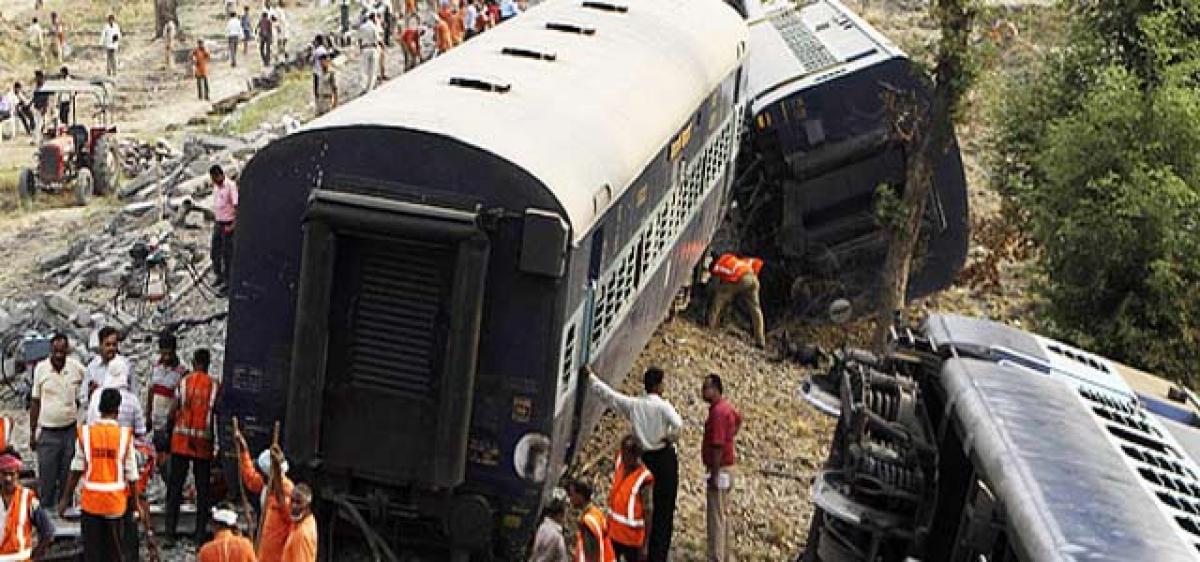Live
- TTD EO inspects Tiruchanoor Brahmotsavam arrangements
- Crisis grips Davanagere farmers despite bumper crop
- NSU probes drug use incident
- Yathindra Siddaramaiah’s statement on judiciary sparks petition for contempt of court
- Initiate steps for implementation of GER: Minister Anam
- Mammootty and Mohanlal to Team Up for Their 50th Film Together
- CAG points out increasing debts during 2022-23
- Youth Commits Suicide in Srikalahasti
- MeT department advises TN fishermen to avoid deep sea fishing
- Scientists decode brain activity that can help treat anxiety and depression
Just In

There may be specific reasons for every accident. But, the larger picture is the derailment of safety ecosystem in Indian Railways.
Parliament, expectedly, witnessed heated scenes in the wake of one of the worst-ever rail disasters.
Even as the government mulls a high-flying plan to roll out bullet trains on Indian tracks, the woefully inadequate safety stares at Indian Railways.
Besides rhetorical statements and statutory inquiries, nothing substantial seems to be happening to bring about a paradigm shift in the approach to rail safety.
There may be specific reasons for every accident. But, the larger picture is the derailment of safety ecosystem in Indian Railways.
Even the High-Level Safety Review Committee (the Kakodkar Committee) appointed by the Ministry of Railways in 2012 observed: “Within the railway system everybody is supposed to look after safety but in reality… (it is) nobody’s baby.”
The Comptroller and Auditor General (CAG) reports further substantiate the utter disregard for safety.
The reasons for accidents include continuing use of overage locomotives, incomplete safety works at level crossings, lack of modernisation of signalling equipment, inadequate maintenance of assets and a failure to make recruitment to the crucial staff positions dealing with safety.
The CAG report of 2012 indicted the Indian Railways for its inability to produce a reliable safety system.
In fact, the Parliamentary panel itself described the pattern of probing of accidents by Commission of Railway Safety (CRS) as "disappointing" and its mandate as "greatly restricted".
The Indian Railways is the largest rail network in Asia and the world’s second largest, under a single management.
This cannot be the justification for the recurring incidence of accidents. Despite lofty claims, safety of passengers seems to be missing in the priorities of railways.
The initial reports on the latest accident reveal that rail fracture seem to be the reason. Experts state that rail fractures occur when a small crack turns into a larger one; usually because of the pressure of heavy bogies travelling over it .
Poor maintenance is the cause of such relatively minor factors that turn fatal when remain unaddressed.
Analysis of rail accidents reveals that derailment due to track defects account for a significant number of accidents.
While this is the pathetic plight of rail tracks in India, there is an attempt to superimpose high speed rail and even bullet trains on Indian Railway network.
Before embarking on such grandiose plans, the urgent priority is to serve the average Indian rail passenger with modernised track network among other things.
Estimates suggest that human failures account for 86 per cent of railway accidents. But, fiscal austerity imposes severe restrictions on human resource costs leaving a very large number of basic manpower posts vacant.
Railways are increasingly seen as a commercial utility rather than a vital infrastructure. As a result the business plans of Railways levy more emphasis on running more and heavier trains on the poorly maintained tracks seriously compromising the quality of tracks and thereby the safety of passengers.
The latest accident should serve as a grim reminder of the conditions of tracks and the men who guard them, besides bringing back the focus on safety.

© 2024 Hyderabad Media House Limited/The Hans India. All rights reserved. Powered by hocalwire.com







